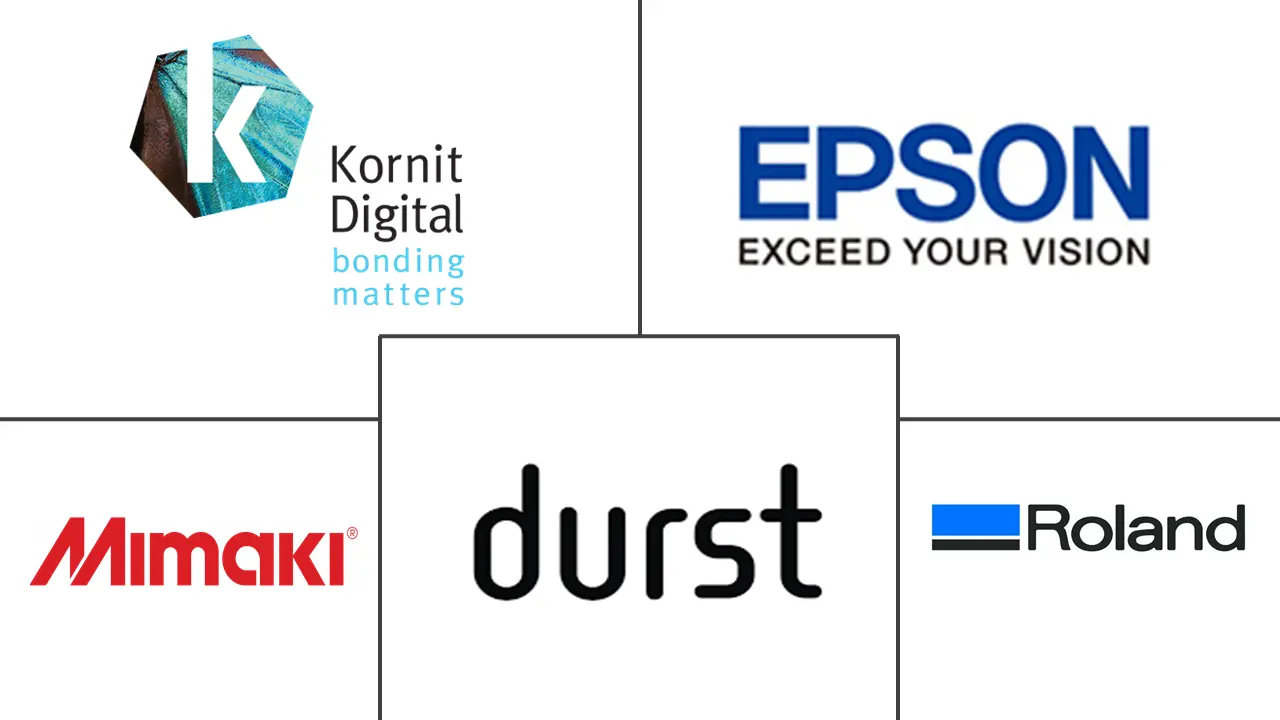Digital Textile Printing Market Size and Share
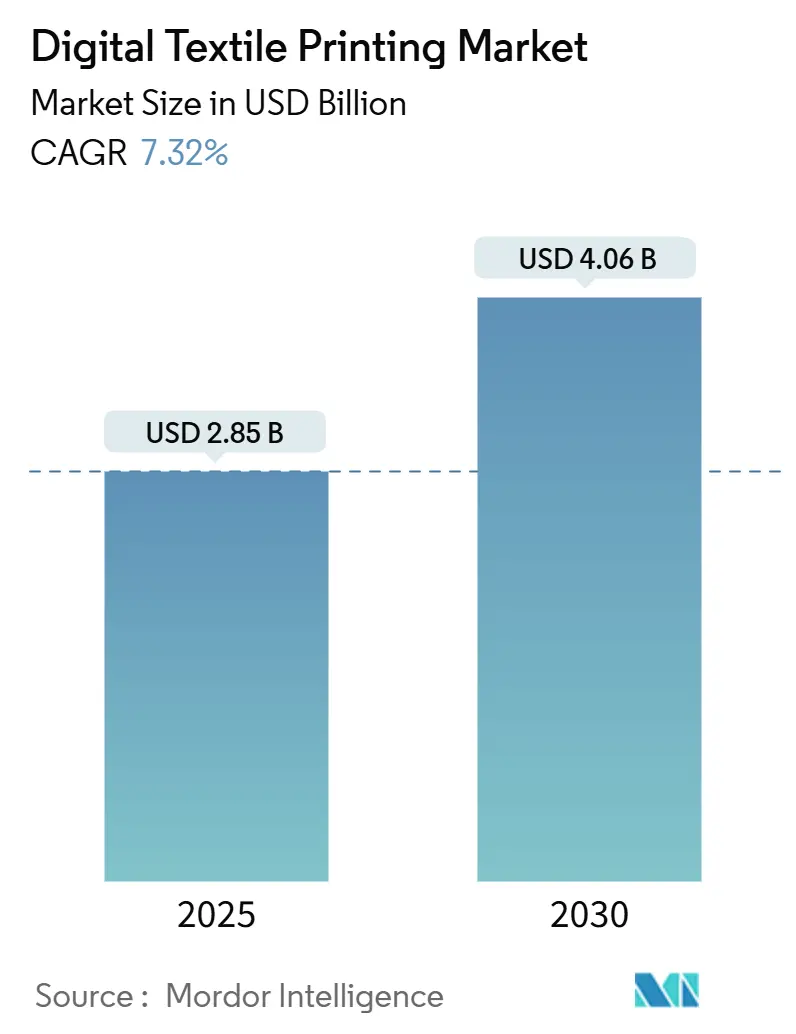
Digital Textile Printing Market Analysis by Mordor Intelligence
The digital textile printing market size is valued at USD 2.85 billion in 2025 and is forecast to reach USD 4.06 billion by 2030, advancing at a 7.32% CAGR. Expanding e-commerce channels, regulatory pressure to reduce water use in finishing operations, and rapid progress in single-pass inkjet technology together create a durable demand curve that outperforms legacy analog printing. Brands now blend micro-collections with on-demand manufacturing to cut inventory risk, while compliance mandates in the European Union and California accelerate the shift toward low-water pigment solutions. Asia-Pacific dominates production because of established supply chains and competitive input costs, yet Middle East and Africa records the fastest adoption as governments diversify away from hydrocarbons and invest in export-oriented manufacturing. On the competitive front, hardware specialists combine proprietary inks, workflow software, and service contracts to lock in recurring revenue and deepen client stickiness.
Key Report Takeaways
- By printing method, Roll-to-Roll held 65.56% of the digital textile printing market share in 2024, while Single-Pass Line technology is projected to expand at a 10.57% CAGR through 2030.
- By ink type, Disperse inks led with 42.34% revenue share in 2024; Sublimation inks are poised for a 9.45% CAGR to 2030.
- By application, Garment and Apparel accounted for 55.67% of the digital textile printing market size in 2024, whereas Technical Textiles is set to grow at an 8.67% CAGR.
- By substrate, Polyester captured 58.56% share of the digital textile printing market size in 2024 and continues to be the fastest-growing substrate at a 10.34% CAGR.
- By geography, Asia-Pacific dominated with 42.56% share in 2024, while Middle East & Africa is advancing at an 11.14% CAGR through 2030.
Global Digital Textile Printing Market Trends and Insights
Drivers Impact Analysis
| Driver | (~) % Impact on CAGR Forecast | Geographic Relevance | Impact Timeline |
|---|---|---|---|
| Personalisation-led micro-collections boom | +1.8% | Global, with concentration in North America & EU | Medium term (2-4 years) |
| Single-pass inkjet productivity leap | +1.5% | APAC core, spill-over to MEA | Short term (≤ 2 years) |
| E-commerce print-on-demand fulfilment | +1.2% | Global, led by North America | Short term (≤ 2 years) |
| Water-saving compliance mandates | +1.0% | EU, expanding to APAC | Medium term (2-4 years) |
| Near-shoring for resilient supply chains | +0.9% | North America & EU | Long term (≥ 4 years) |
| On-garment sustainable pigment advances | +0.8% | Global | Long term (≥ 4 years) |
| Source: Mordor Intelligence | |||
Personalisation-led micro-collections boom
Labels now pilot capsule lines in weekly drops, eliminating minimum order quantities and monetising higher margins on customised apparel. Kornit Digital’s Apollo platform enables companies such as T-Formation to release same-day designs that meet shifting consumer tastes. Print-on-demand players consolidate capacity—as seen in the 2024 Printful/Printify merger—to serve this surge in bespoke garments. Lower inventory risk, premium price points, and dramatically shorter design-to-shelf cycles collectively lift throughput across the digital textile printing market. The trend also supports circular economy objectives by reducing surplus stock and related waste. Demand for design-to-garment workflows therefore remains a central accelerator for the next phase of market expansion.
Single-pass inkjet productivity leap
Single-pass printers lay down an entire image in one motion, reaching speeds 10-20 times faster than classic multi-pass systems. Delta Group’s third EFI Nozomi 14000 SD installation underscores how brands replace analog lines to cut lead times for display graphics. Mimaki’s Tiger600-1800TS, launched in February 2025 for MEA users, offers similar gains in dye-sublimation throughput. Machine-learning-driven calibration ensures colour consistency at industrial scale. As cost per square metre falls in parallel with cycle times, single-pass adoption widens the addressable base for the digital textile printing market, especially where weekly or daily product refreshes are the norm.
E-commerce print-on-demand fulfilment
Marketplaces integrate direct-to-consumer production so creators can upload designs that are printed only after purchase, eradicating unsold inventory. Caldera’s cross-platform Direct-to-Film toolkit automates artwork preparation for smaller sellers.[1]Dover Corporation, “Caldera Introduces New Direct-to-Film Solution for Digital Textile Printing,” investors.dovercorporation.com Kornit Digital and Fashion Enter’s London-based Fashtech Innovation Centre ties vocational upskilling with on-demand machinery to close the UK’s sewing capacity gap. Spoonflower’s community of independent designers demonstrates how friction-free digital workflows unlock incremental revenue without traditional manufacturing constraints. Fulfilment centres therefore function as micro-factories that keep momentum in the digital textile printing market by matching real-time online demand with equally agile production.
Water-saving compliance mandates
Textiles fall under the EU Ecodesign for Sustainable Products Regulation 2025-2030, compelling mills to cut resource intensity. EFI Reggiani’s ecoTERRA platform reports up to 80% water savings versus analog dyeing. RUDOLF’s formaldehyde-free Digital Pigment Printing Toolbox removes wash-down steps while maintaining rub fastness. Member states now legislate Extended Producer Responsibility schemes that shift end-of-life costs onto brands, incentivising lower-impact print routes. These policy moves cement sustainable processes as a competitive baseline in the digital textile printing market.
Restraints Impact Analysis
| Restraint | (~) % Impact on CAGR Forecast | Geographic Relevance | Impact Timeline |
|---|---|---|---|
| High capex for industrial systems | -1.2% | Global, particularly emerging markets | Medium term (2-4 years) |
| Ink–fabric compatibility hurdles | -0.8% | Global, with emphasis on technical textiles | Short term (≤ 2 years) |
| Colour-fastness QA bottlenecks | -0.6% | Global, critical in apparel applications | Medium term (2-4 years) |
| PFAS-linked pigment regulatory risk | -0.8% | EU, North America, expanding globally | Short term (≤ 2 years) |
| Source: Mordor Intelligence | |||
High capex for industrial systems
Entry-level single-pass lines cost USD 500,000–USD 2 million, placing them beyond the reach of many SMEs. Financing barriers are more acute in regions with under-developed capital markets, extending payback horizons and slowing equipment refresh cycles. Leasing programmes and print-as-a-service contracts from OEMs help amortise costs, yet the burden of consumables—which can equal 40–60% of operating expenditure—remains. The digital textile printing market therefore advances unevenly until capital hurdles are offset by lower per-unit costs and quicker order-to-cash timelines.
PFAS-linked pigment regulatory risk
France bans PFAS in textiles by 2026, and New York plus California enforce similar rules from 2025. Ink makers must reformulate chemistries without sacrificing colour gamut or wash durability, driving R&D spend up and creating uncertainty in supply chains. OEKO-TEX test regimes add compliance costs for mills, and temporary shortages of certified alternatives could constrain output. The resulting disruption lowers near-term growth in the digital textile printing market where PFAS-based formulations are still prevalent.
Segment Analysis
By Printing Method: Productivity and Flexibility in Tandem
Roll-to-Roll systems delivered 65.56% of the digital textile printing market size in 2024, supported by their compatibility with high-volume apparel, soft-signage, and home-textile runs. Continued improvements in printheads and inline fixation keep cost per square metre attractive, ensuring enduring relevance for bulk orders. Concurrently, Single-Pass Line platforms are scaling fastest at a 10.57% CAGR, bringing industrial throughput to low-run jobs and enabling brands to merge sampling and mass production on one line. Hybrid configurations that marry analog under-bases with digital overprints now help converters maximise uptime while flexibly deploying screens or inkjets to match artwork complexity.
The digital textile printing market benefits when converters adopt direct-to-garment options that share single-pass heads, reducing equipment redundancy and inventory. EFI, Mimaki, and Kornit Digital each package colour management, maintenance analytics, and workflow automation in their ecosystems, raising switching costs. For enterprises still amortising legacy screens, modular retrofits offer a transitional path, mitigating capex risk without stalling digital transition.
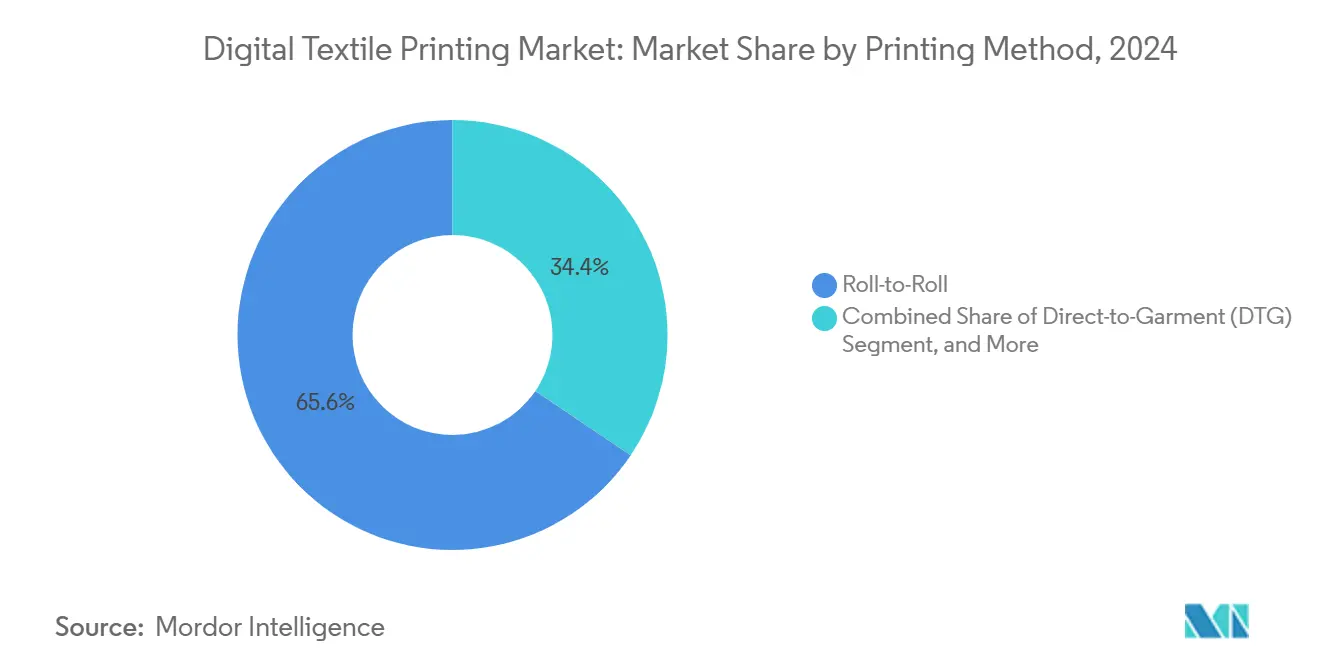
Note: Segment shares of all individual segments available upon report purchase
By Ink Type: Chemistry Aligned with Application Needs
Disperse inks captured 42.34% of the digital textile printing market share in 2024, cemented by polyester’s reigning material dominance. Sublimation chemistries, however, notch the quickest 9.45% CAGR because sportswear, promotional flags, and backlit displays prize vivid, durable colour that sublimates into fibre with minimal post-treatment. Pigment sets gain favour as waterless workflows and one-step finishing address tightening environmental codes; OEM introductions such as DuPont’s Artistri® PN1000 series illustrate the pivot from reactive dyes toward greener, cross-substrate options.[2]DuPont, “DuPont to Showcase New Innovative Artistri® Digital Printing Inks at drupa 2024,” dupont.com
Reactive inks hold sway in cotton-heavy regions where deep shade penetration and wash resistance are mission-critical, while acid inks cater to silk and wool, sustaining premium segments. Ink innovation continues to revolve around lowering curing temperatures and improving nozzle open time, factors that directly influence uptime economics in the digital textile printing market.
By Application: Functional Use-Cases Multiply
Garment and Apparel dominated with 55.67% contribution to the digital textile printing market size in 2024, bolstered by fast-fashion cycles and direct-to-consumer brands demanding real-time replenishment. Yet Technical Textiles post the highest 8.67% CAGR as sectors such as automotive, medical, and aerospace specify lightweight, performance fabrics with embedded graphics. India’s National Technical Textiles Mission, aimed at USD 10 billion exports by 2030, incentivises mills to pivot toward filtration media, protective gear, and geo-textiles.
Home Décor remains a fertile niche as personalisation spills into curtains, upholstery, and bedding, areas historically constrained by long strike-offs and high sampling costs. Display graphics extend beyond event signage to include retail soft-fabric façades that demand rapid change-outs, further reinforcing order diversity. Machine-learning-assisted topology optimisation now guides composite designs, highlighting how the digital textile printing market intersects advanced materials engineering.
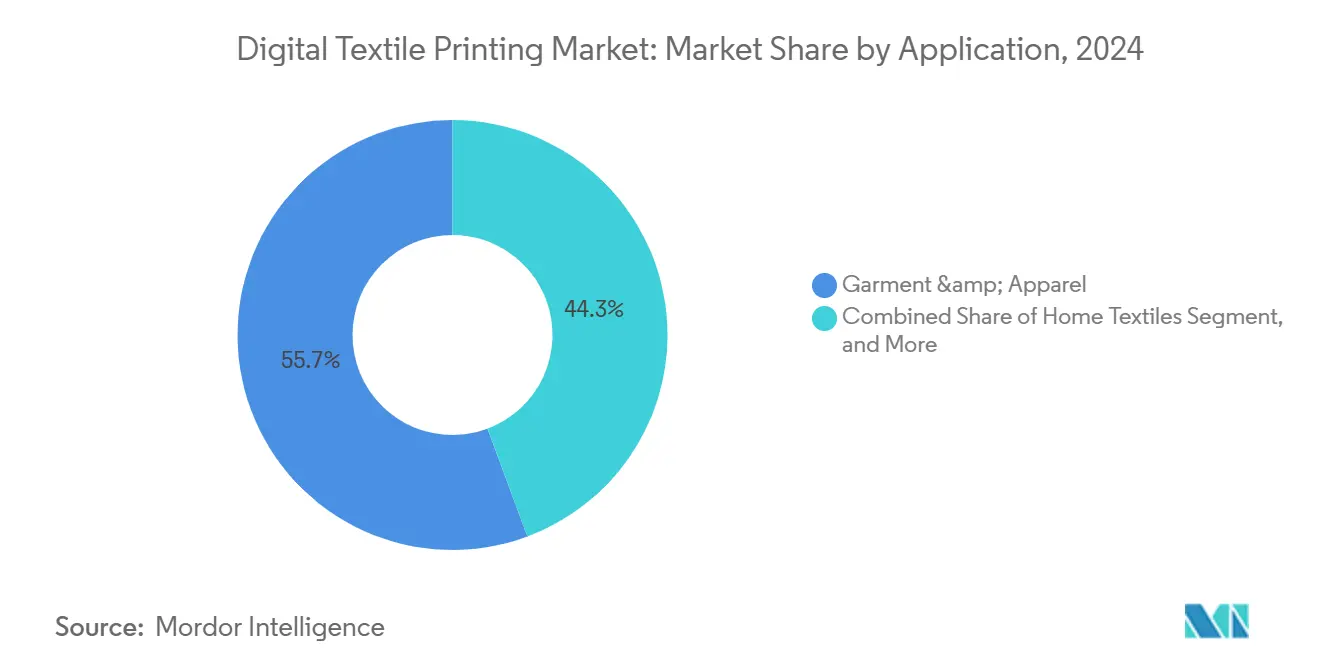
Note: Segment shares of all individual segments available upon report purchase
By Substrate: Synthetic Momentum
Polyester represented 58.56% of the digital textile printing market size and is also the fastest-growing substrate at 10.34% CAGR, a rare duality underpinned by low cost, durability, and synergy with sublimation and disperse ink systems. Recycling initiatives that transform PET bottles into polyester yarns strengthen the material’s sustainability narrative, feeding corporate ESG goals. Cotton remains second in volume, valued for comfort and breathability, though its water-intensive cultivation pushes brands toward organic or recycled blends.
Silk supports luxury scarves and couture, with acid ink advances improving lustre without compromising hand feel. Nylon’s tensile strength finds favour in activewear and parachute fabrics, while multi-fibre blends tailor mechanical and aesthetic properties to end-use. OEM ink roadmaps increasingly align with substrate evolution, ensuring the digital textile printing market scales with both resource-efficient synthetics and responsibly sourced naturals.
Geography Analysis
Asia-Pacific controlled 42.56% of global shipments in 2024, anchored by China’s USD 77.9 billion yarn and fabric exports and India’s aggressive policy packages, including seven PM MITRA parks backed by USD 2.2 billion in incentives. Lower labour rates, dense supplier clusters, and deep port networks keep landed costs competitive even as energy and environmental rules tighten. Regional OEM partnerships funnel single-pass equipment into vertically integrated mills, lowering the adoption barrier for niche brands entering the digital textile printing market.
Middle East & Africa registers the sharpest 11.14% CAGR to 2030 as governments pursue diversification. The UAE and Saudi Arabia leverage free-zone incentives while Egypt teams with Turkish producers to supply US buyers, taking advantage of USD 103 monthly minimum wages. Infrastructure projects such as industrial parks in Morocco and Ethiopia attract foreign direct investment that positions the region as an agile, tariff-hedged alternative to Asian sourcing.
Europe emphasises ecological compliance under the ESPR, prompting mills to adopt water-saving pigment workstreams and recycled fibre blends. Brands near-shore micro-capsule runs to shorten delivery windows, a strategy aligned with the continent’s mature consumer base demanding transparency and sustainable credentials. North America’s reshoring renaissance advances at 2.8% annual growth since 2020, with players like Shawmut Infinite investing USD 8 million to modernise integrated knit-to-finish lines. South American growth is steady yet hampered by logistics gaps and macro volatility, limiting its share of the digital textile printing market despite favourable raw-material availability.
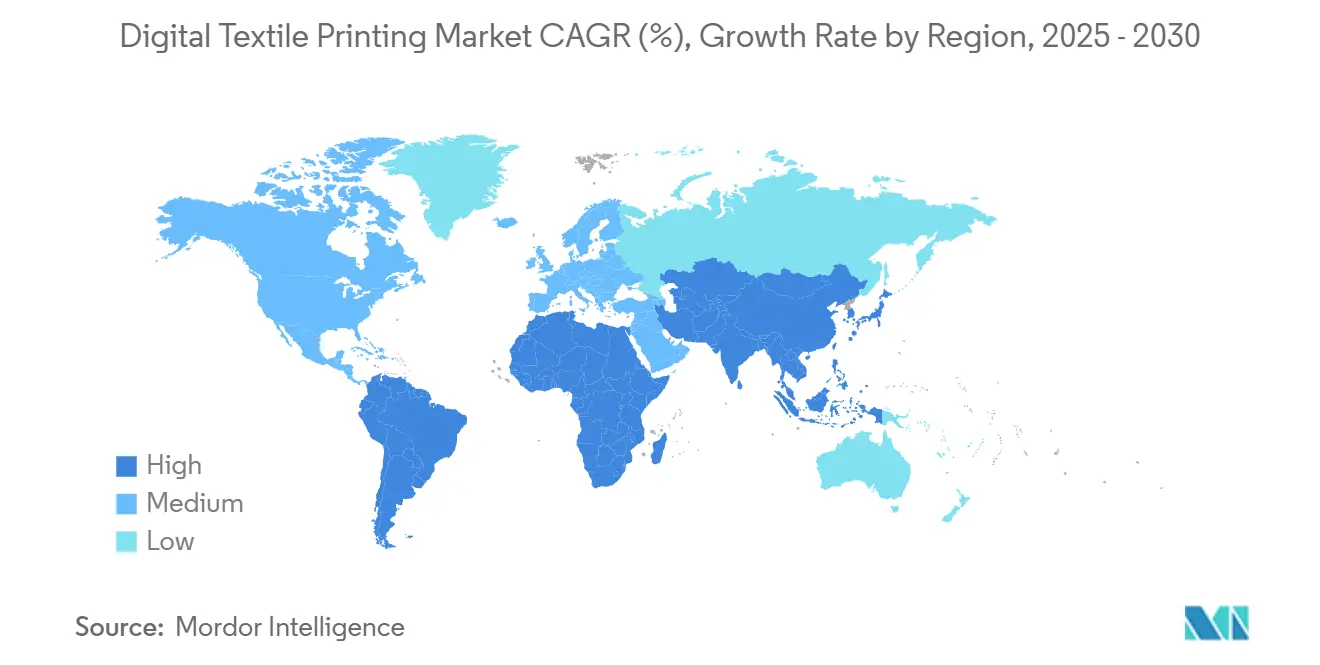
Competitive Landscape
The digital textile printing market remains moderately fragmented; yet leading five vendors collectively hold an estimated 55–60% revenue, reflecting a market concentration score of 6. Kornit Digital blends hardware, cloud-based firmware, and consumables to lock clients into its subscription model, while the USD 100 million share-buyback underscores confidence in multi-year earnings expansion.[3]Kornit Digital, “Kornit Digital Reports Third Quarter 2024 Results,” ir.kornit.com EFI Reggiani scales eco-TERRA pigment lines that allow mills to bypass post-washing, cementing its green-print credentials.
Acquisitions target chemistry breadth and geographic spread. Archroma’s 2025 purchase of Huntsman Textile Effects adds 2,300 staff and deepens presence in water-borne auxiliaries. Avient’s earlier move for Magna Colours injects water-based ink IP into its polymer portfolio, bridging packaging and textile verticals. Such moves clarify a playbook centred on building turnkey ecosystems that cover equipment, software, and certified consumables.
New entrants compete on application specificity—direct-to-film kits, compact DTG units, or smart-textile integration—rather than scale. Open-source RIP software and low-cost Asian printheads lower technical barriers but leave service credibility as a decisive factor. Vendors therefore bundle predictive maintenance, operator training, and just-in-time parts logistics to neutralise price-led competition and retain margin in the digital textile printing market.
Digital Textile Printing Industry Leaders
-
Kornit Digital
-
Seiko Epson Corporation
-
Mimaki Engineering
-
Durst Group
-
Roland DG Corporation
- *Disclaimer: Major Players sorted in no particular order
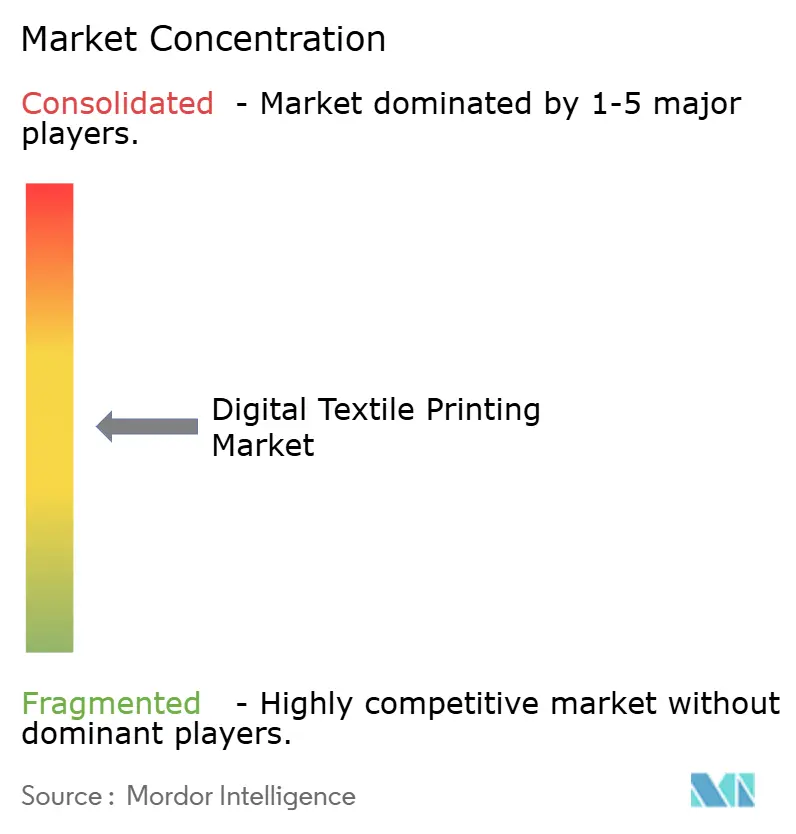
Recent Industry Developments
- March 2025: Archroma completed the acquisition of Huntsman Corporation's Textile Effects business, creating a 5,000-employee entity focused on sustainable chemistry.
- February 2025: Mimaki introduced the Tiger600-1800TS dye-sublimation printer to accelerate uptake in MEA markets.
- February 2025: India approved seven PM MITRA parks with total investment of INR 18,500 crore (USD 2.2 billion).
- January 2025: France legislated a PFAS ban in textiles effective 2026.
Global Digital Textile Printing Market Report Scope
Digital textile printing is a straightforward technique that involves using customized inkjet technology to print designs directly onto fabric.
The digital textile printing market is segmented by printing method (roll-to-roll printing and direct garment printing), type (sublimation, pigment, reactive, and other types), application (garment and apparel, household, and display and signage), substrate (cotton, silk, polyester, and other substrates), and geography (North America, Europe, Asia-Pacific, Latin America, and Middle East and Africa).
The market sizes and forecasts are provided in terms of value (USD) for all the above segments.
| Roll-to-Roll Printing |
| Direct-to-Garment (DTG) |
| Single-Pass Line |
| Hybrid (Analog + Digital) |
| Other Printing Method |
| Sublimation |
| Pigment |
| Reactive |
| Acid |
| Disperse |
| Garment and Apparel |
| Home Textiles |
| Technical Textiles |
| Display and Signage |
| Cotton |
| Polyester |
| Silk |
| Nylon |
| Blends |
| North America | United States | |
| Canada | ||
| Mexico | ||
| Europe | Germany | |
| Italy | ||
| United Kingdom | ||
| France | ||
| Spain | ||
| Russia | ||
| Rest of Europe | ||
| Asia-Pacific | China | |
| Japan | ||
| India | ||
| South Korea | ||
| Australia and New Zealand | ||
| Rest of Asia-Pacific | ||
| Middle East and Africa | Middle East | Turkey |
| Saudi Arabia | ||
| United Arab Emirates | ||
| Rest of Middle East | ||
| Africa | South Africa | |
| Egypt | ||
| Rest of Africa | ||
| South America | Brazil | |
| Argentina | ||
| Rest of South America | ||
| By Printing Method | Roll-to-Roll Printing | ||
| Direct-to-Garment (DTG) | |||
| Single-Pass Line | |||
| Hybrid (Analog + Digital) | |||
| Other Printing Method | |||
| By Ink Type | Sublimation | ||
| Pigment | |||
| Reactive | |||
| Acid | |||
| Disperse | |||
| By Application | Garment and Apparel | ||
| Home Textiles | |||
| Technical Textiles | |||
| Display and Signage | |||
| By Substrate | Cotton | ||
| Polyester | |||
| Silk | |||
| Nylon | |||
| Blends | |||
| By Geography | North America | United States | |
| Canada | |||
| Mexico | |||
| Europe | Germany | ||
| Italy | |||
| United Kingdom | |||
| France | |||
| Spain | |||
| Russia | |||
| Rest of Europe | |||
| Asia-Pacific | China | ||
| Japan | |||
| India | |||
| South Korea | |||
| Australia and New Zealand | |||
| Rest of Asia-Pacific | |||
| Middle East and Africa | Middle East | Turkey | |
| Saudi Arabia | |||
| United Arab Emirates | |||
| Rest of Middle East | |||
| Africa | South Africa | ||
| Egypt | |||
| Rest of Africa | |||
| South America | Brazil | ||
| Argentina | |||
| Rest of South America | |||
Key Questions Answered in the Report
What is the current value of the digital textile printing market?
The digital textile printing market is valued at USD 2.85 billion in 2025 and is projected to reach USD 4.06 billion by 2030 with a 7.32% CAGR.
Which printing method is growing the fastest?
Single-Pass Line technology is the fastest-growing printing method, expected to post a 10.57% CAGR through 2030.
Why is polyester the dominant substrate in digital textile printing?
Polyester combines low cost, durability, and compatibility with disperse and sublimation inks, capturing 58.56% market share in 2024 and expanding at a 10.34% CAGR.
How are PFAS regulations affecting the sector?
France, New York, and California have enacted PFAS bans, pushing ink manufacturers to develop compliant chemistries and adding near-term cost and supply-chain complexity.
Which region offers the strongest growth momentum?
Middle East and Africa is forecast to grow at 11.14% CAGR, driven by industrial diversification initiatives and strategic location between European and Asian markets.
What is the chief barrier to adoption for smaller firms?
High capital expenditure—ranging from USD 500,000 to USD 2 million for industrial single-pass systems—remains the principal constraint, though leasing and print-as-a-service models are easing entry.
Page last updated on:
